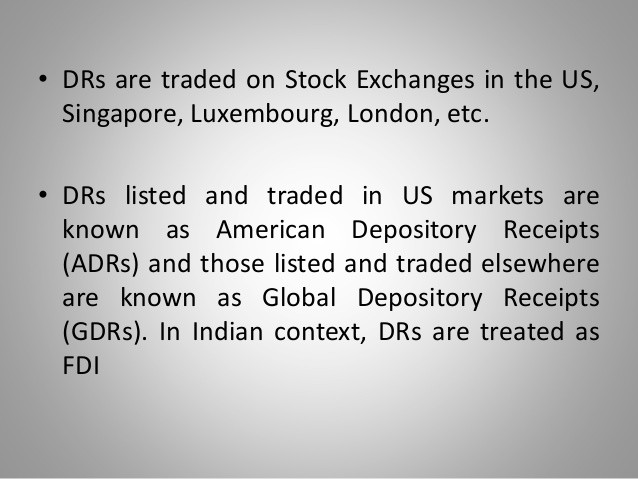A Primer on American Depositary Receipts (ADRs)
Post on: 31 Май, 2015 No Comment

A merican Depositary Receipts (ADRs) are securities of non-US corporations that trade in the US stock markets . Individual shares of such foreign securities represented by ADRs are called as American Depositary Shares. ADRs are created when a broker purchases shares of a non-US corporation on its home stock exchange and transfers them to a local custodian bank, which issues the receipts.
ADRs provide North American investors the means to buy shares in a foreign company such as those listed in the UK, China, or France to name but a few. These ADRs, denominated in US dollars, are traded similar to domestic stocks on the US exchanges, pay dividends in US dollars, and enable an investor to diversify their asset allocation using their local brokerage account .
Why are ADRs used?
For a foreign corporation, issuing a depositary receipt:
- Widens and diversifies their market share.
- Provides an avenue to increase their capital pool.
- Facilitates mergers and acquisitions.
For an investor, buying a depositary receipt:
- Allows investment in successful foreign companies, while using their local brokerage account and local currency (US dollars).
- Does not pose any unfamiliar transaction requirements due to the known trade procedures.
- Provides global stock diversification, while avoiding the management fees associated with mutual funds and ETFs.

What are the drawbacks?
Apart from the usual due diligence required before purchasing a domestic stock, investing in foreign corporation needs added attention (inflation risk, credit risk, etc.). The fundamental and technical aspects of stock analysis may remain the same for foreign stocks but there may be geopolitical issues in that country that an investor would need to be aware of.
For example, buying shares of a corporation based out of a dictatorial regime may be recipe for investment disaster as political unrest may throw the country into an economic tailspin. In addition, the currency of the home country throws another variable into the mix. Since ADRs are based upon the shares of the corporation in its home country, a fall in the valuation of the home currency will reflect on the depositary receipt.
Levels of ADRs
Level I. These ADRs are highly speculative investments that are traded over-the-counter and not on US exchanges. Information about these ADRs is not easily available as reporting regulations across the world are not as stringent as North America.
Level II. These ADRs follow more stringent reporting requirements than Level I ADRs. Foreign companies registered as Level II ADRs fall under US SEC regulations. These corporations are required to file an annual Form 20-F, which is similar to the Form 10-K for a US company. In addition, the reports created by the foreign corporation must follow standard accounting principles such US GAAP or International Financial Reporting Standards.
Level III. Being the highest level of ADRs, companies under this program have to abide by more stringent rules than Level II ADRs. Under this program, a foreign company is using its depositary receipt to raise capital and hence, files Form F-1 (format for Offering Prospectus) in addition to Form 20-F. Information disclosed to investors in its home stock market must be filed with the SEC (Form 6K) to provide transparency.
Tax Issues
ADRs are treated similar to US stocks; so, capital gains and dividends are taxed at the same rates as US stocks. Nonetheless, an investor should investigate if withholding taxes apply on dividends paid by the foreign corporation and if so, use the appropriate deduction/credit (US/Canada) while filing their income tax.
Do you invest in ADRs? If so, do you buy companies with solid fundamentals or are you using your play money to ride a wave? How have your ADR investments fared till date?
About the Author. Clark works in Saskatchewan and has been working to build his (DIY) investment portfolio, structured for an early retirement. He loves reading (and using the lessons learned) about personal finance, technology and minimalism. You can read his other articles here .














